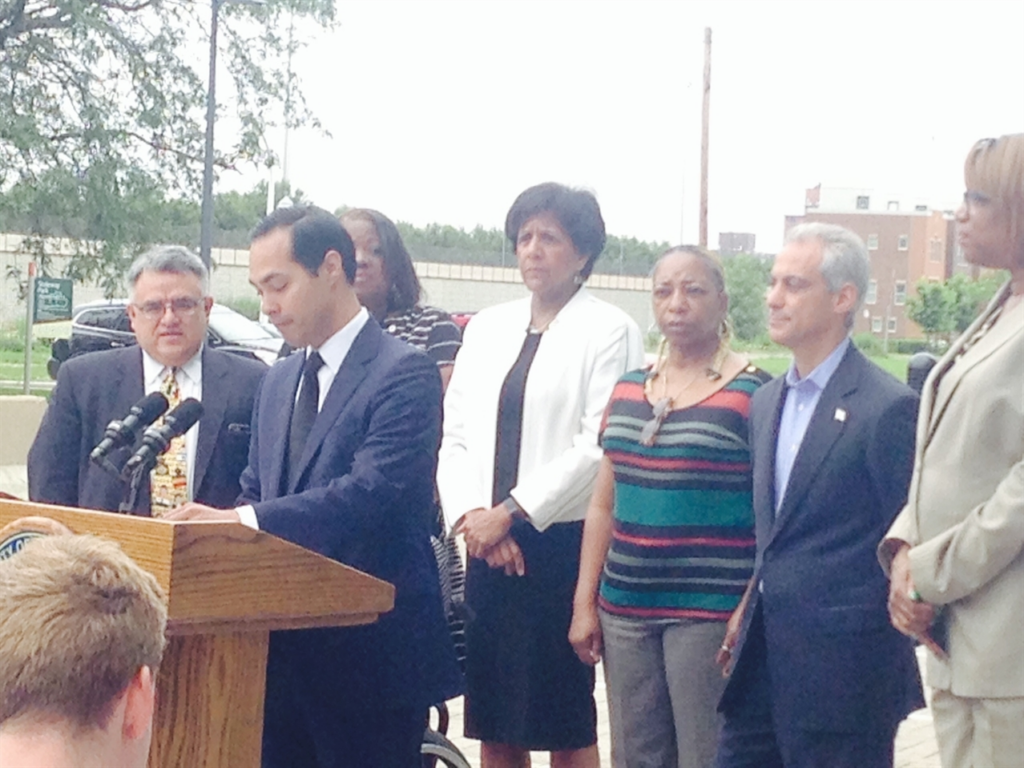How Can We Make It Easier for Developers and Communities To Deliver the Affordable Housing We Need?

It’s been an incredibly interesting time for those, like me, who are passionate about affordable housing and community development. The Supreme Court ruled on June 25, 2015, that the Fair Housing Act is violated if policies segregate minorities into low-income areas, even if unintentionally. On July 8, I was in the audience for Dept. of Housing and Urban Development Secretary Julian Castro’s Chicago announcement of the final rule on Affirmatively Furthering Fair Housing, clarifying that grantees must proactively promote fair housing and equal opportunity. (Translation: Municipalities and public housing authorities receiving Housing and Urban Development dollars will be held accountable that their housing policies do not perpetuate concentrated poverty.) On July 16, MPC—along with the Center on Budget and Policy Priorities and Poverty & Race Research Action Council—hosted the Sixth Annual Conference on Housing Mobility to highlight the latest research and best practices for assisting families moving from areas of concentrated poverty to “opportunity areas”—those with low poverty and high access to jobs and transportation.
The new rule in particular is generating a lot of buzz. Some have bemoaned the rule as social engineering that will create a world without social barriers and “make every neighborhood look like Detroit.” Others have argued that local communities should be left alone to decide what’s best for them. Still others—those who provide affordable housing in low-income neighborhoods—have expressed concern that the rule will hamper their ability to provide units to a population that needs them.
To those who view life without social barriers as a bad thing, I simply cannot relate. To those who think communities should make these decisions themselves, well, we have a long track record of how that has panned out. Essentially, we’ve invested enormous sums of money into subsidizing our own separation—damaging our economy as a result. A recent University of Minnesota study (which I’ve written about before) found that in the Twin Cities, federal housing dollars are spent equally—and separately—in wealthy and poor communities: Low-income families receive federal support through housing vouchers and subsidized units, while middle-class and wealthy families receive federal subsidy through their mortgage-interest deduction. One can see this pattern in Chicago, where most affordable subsidized housing is on the South and West sides and rates of homeownership are highest in wealthy areas.
For those providing subsidized housing in distressed communities, the long view is needed. This rule is corrective action for decades of imbalance. Think of the model we’ve had since the late 1960s with the rise of the community development corporation, most of which are rooted in a community or a few contiguous communities, in areas that are usually struggling with disinvestment. Addressing those struggles is the reason for their existence. Over time, particularly with the creation of Low Income Housing Tax Credits in 1987, these community development corporations increasingly focused less on their original raison d’etre of building local power through job creation and more on housing production. And with good reason: Any household paying more than 30 percent of its income toward housing is considered housing cost-burdened, and in 2009 nearly 55 percent of renters citywide met this definition, according to the Chicago Rehab Network. On the South and West sides, the percent of renters who were cost-burdened was as high as 68 percent. While housing units may rent for less than elsewhere in the city simply because land values are low, rents are nowhere near as low as they need to be. Further, the older housing stock in these areas is more likely not to have been rehabbed and, when replete with lead paint, radon and mold, more likely to be dangerous to its occupants. So the work is needed, no doubt.
We err when we make low-income areas the predominant recipients of what should be city-wide and region-wide investments in affordable housing. Doing so not only further entrenches poverty and segregation, it is also damaging to our overall economy.
But there is also no denying that we’ve settled into a pattern in our cities in which community development corporations and nonprofit developers produce the subsidized housing that is needed everywhere predominantly in low-income communities. When considering Low-Income Housing Tax Credits units at a minimum, here in Chicago we’ve asked the South and West sides to bear the great majority of the brunt of providing this housing, and we’ve given a lot of the rest of the city a pass. These South and West side neighborhoods are the very same that have absorbed decades of discriminatory mortgage lending, “buying on contract” (as chronicled in Ta-Nehisi Coates’ The Case for Reparations) and most of the city’s public housing units. These areas desperately need what Patrick Sharkey calls durable investment, which certainly includes subsidized housing for all the reasons noted above. However, we err when we make these areas the predominant recipients of what should be city-wide and region-wide investments in affordable housing. Doing so not only further entrenches poverty and segregation, it is also damaging to our overall economy.
Yes, a shift in funding priorities now could be a loss for community development corporations, and I don’t take that lightly. I lived and worked in North Lawndale for more than a decade, much of that time at one of these corporations. And if they feel attacked on all sides, I don’t blame them; the Community Development Block Grant program once went directly to these corporations, but has become less project-specific and is instead now dispersed to state and local governments. Like other federal funds, the dollar amount itself has dropped dramatically as well: a 59 percent decrease since 1981. As for HOME funds—key to filling the funding gap in Low-Income Housing Tax Credit deals—the FY2016 budget shows them as essentially zeroed out.
But let’s be clear: Community development corporations never should have been shouldering so much of the affordable housing provision role to begin with. It’s kind of like when I hear car drivers complain about having to share the road with bicyclists. Who ever said roads were just for cars? Over the years, we made deliberate decisions that privileged cars over other modes of transport, and we’ve come to define that as normal. Similarly, we haven’t before taken a strong stance that it would be good for individuals and good for our economy if low-income residents were able to live affordably throughout our city.
Some will argue that distressed communities need more investment, not less; I couldn’t agree more. But let’s not confuse the myriad investments needed in distressed communities with a singular focus on affordable housing development. For some communities, the top priority for place-based investments would be a grocery store, a new transit stop and additional services in schools. In this article, longtime community development corporation Director Jim Capraro outlines the importance of these entities organizing for export-driven economic development benefits at scale. These corporations can—and historically have—led the way in securing needed investments as well.
In addition, there may be opportunity here for a varied geography. The Resurrection Project, for instance, works primarily in Chicago’s Pilsen, Little Village and Back of the Yards neighborhoods. As Pilsen has gentrified, the Resurrection Project has found it increasingly challenging to build affordable units there. Likewise, the Latin United Community Housing Association has seen costs of acquisition soar for lots in West Town, Humboldt Park and Logan Square, its traditional areas of affordable housing development. Yet with a newfound emphasis on “opportunity areas” from funders, they now may have the ability to ramp back up in neighborhoods they’ve spent decades working to improve. These examples highlight an important truth overlooked in complaints that the new Dept. of Housing and Development rule and mobility efforts make poor people move to solve a place-based problem: As communities like Pilsen and Logan Square experience rising land values and become unaffordable to longtime low-income residents, the new rule provides an opportunity to build the units that can help them stay. Moving beyond community development corporations, developers who create affordable housing across a wide geography now may have more willing partners and municipalities, not less.
But a mandate does not necessarily a change make, for the simple truth that affordable housing in high-income areas is harder to accomplish than development in areas where land values are lower. It’s harder not only because of continuing discrimination but also because it’s tough to make the numbers work. Developers who buy land in Glenview—as featured in this recent Atlantic article—might pay three times the cost as in South Holland, which makes charging affordable rents in Glenview all the more difficult. How do we make it easier for developers and communities to deliver the affordable housing we need?
With Secretary Castro’s recent announcement on Affirmatively Furthering Fair Housing, it appears the government is ready to address some of the damage that federal housing policies have caused over decades, but it would sure be helpful if it shifted its own resources in order to most effectively do so. Other resource shifts would involve congressional action, such as an increased Low-Income Housing Tax Credit allocation, a fixed 9 percent rate for those credits and restoring cuts to soft funds like HOME and Community Development Block Grants, for example, which could ensure that both South Holland and Glenview are funded for the subsidized housing that they need, rather than either/or. (And while we’re talking federal housing policy, how about a subsidy program that actually provides for the poorest of the working poor? Someone working full-time at Illinois’ minimum wage of $8.25 earns $17,160 annually, while the Low-Income Housing Tax Credits option provides for individuals earning between $26,600 and $31,920; that gap only grows larger if the wage earner has dependents. It’s an ironic truth that most residents of Chicago’s poorest neighborhoods don’t earn enough for these units.)
So, we’ve had decades of funding for distressed families in the places they live, and little required of high-income areas to include affordability. We’ve started moving in a direction that’s correcting for that. The City’s Affordable Requirements Ordinance now requires some affordable units on site in higher-income neighborhoods. The Illinois Housing Development Authority now gauges Low-Income Housing Tax Credit requests based on how many are in opportunity areas, how many are in distressed communities and trying to balance them both. Earlier this year, the U.S. Dept. of Housing and Urban Development renewed funding for the Regional Housing Initiative, a collaboration among nine Chicago-area public housing authorities to pool resources allowing low-income people a choice to live affordably in areas with strong schools, low crime and connections to jobs.
We absolutely should be working to transform distressed communities into areas of opportunity, especially in a city where the number of neighborhoods of low and very low socioeconomic status has grown from 29 community areas in 1970 to 45 community areas in 2010. My suggestion is simply that a total 77-community-area strategy is needed.
We are starting to provide more options for people whose choices have been incredibly constrained, and this is long overdue. We’ve only had fair housing laws in this country for 50 years. Discrimination has been around a heck of a lot longer than that.
